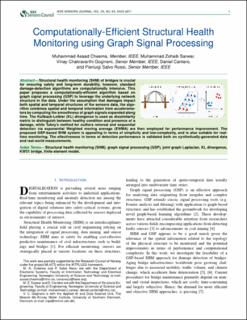Computationally-Efficient Structural Health Monitoring using Graph Signal Processing
Cheema, Muhammad Asaad; Sarwar, Muhammad Zohaib; Gogineni, Vinay Chakravarthi; Cantero Lauer, Daniel; Salvo Rossi, Pierluigi
Peer reviewed, Journal article
Accepted version
Permanent lenke
https://hdl.handle.net/11250/3126111Utgivelsesdato
2024Metadata
Vis full innførselSamlinger
Originalversjon
10.1109/JSEN.2024.3366346Sammendrag
Structural health monitoring (SHM) of bridges is crucial for ensuring safety and long-term durability, however, standard damage-detection algorithms are computationally intensive. This article proposes a computationally efficient algorithm based on graph signal processing (GSP) to leverage the underlying network structure in the data. Under the assumption that damages impact both spatial and temporal structures of the sensor data, the algorithm combines spatial and temporal information from accelerometers by computing the smoothness of graph signals expanded along time. The Kullback–Leibler (KL) divergence is used as dissimilarity metric to distinguish between healthy condition and presence of a damage, while Tukey’s method for outliers removal and sequential detection via exponential weighted moving average (EWMA) are then employed for performance improvement. The proposed GSP-based SHM system is appealing in terms of simplicity and low-complexity and is also suitable for real-time monitoring. The effectiveness in terms of detection performance is validated both on synthetically generated data and real-world measurements.

